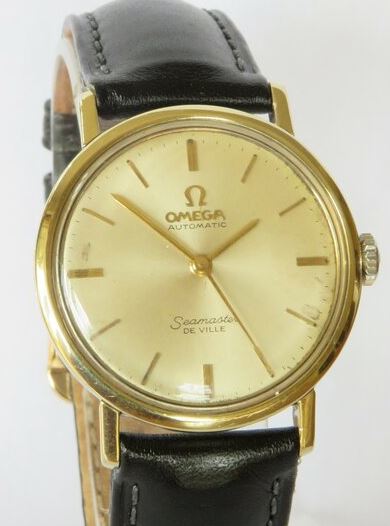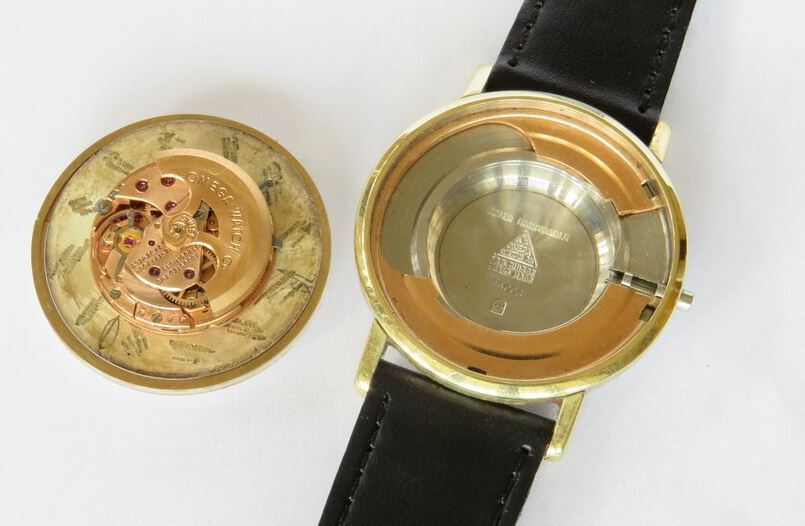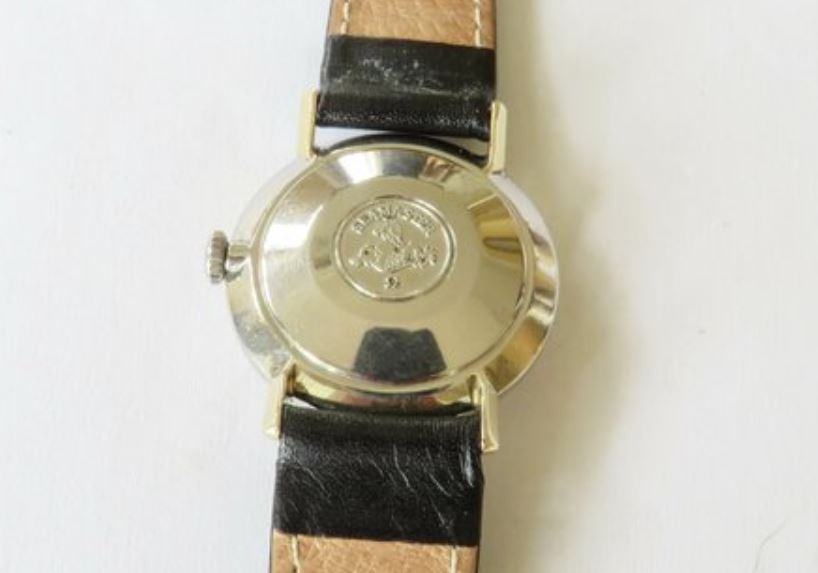Last Updated on June 29, 2024 by Jason
This vintage watch is a class Omega Seamaster De Ville dating from 1965. It is a stylish timepiece in good condition overall considering its age, this is the perfect example of a vintage watch you would want to wear. The watch has an Omega calibre 671 24-jewel automatic movement which is keeping good time. The movement is fully signed and has the serial number 22,572,210 which dates it back to 1965.
Omega
Founded in 1848 by Louis Brandt in La Chaux-de-Fonds, Switzerland, Omega initially operated as a modest workshop assembling pocket watches. Brandt’s commitment to quality and craftsmanship quickly earned Omega a reputation for precision timekeeping.
In 1894, Omega revolutionised watchmaking with the introduction of the 19-ligne Omega calibre, which would later be named the Omega movement. After the ongoing success of the 19-ligne calibre, the company officially adopted the brand name Omega in 1903.

By the early 20th century, Omega had gained worldwide recognition for accuracy and reliability. The brand’s watches were utilised in various sporting events and expeditions, including the Olympics and polar explorations. Notably, Omega became the official timekeeper for the Olympic Games in 1932, consolidating its reputation as a leader in sports timekeeping.
During World War II, Omega supplied watches to the British Royal Air Force and other Allied forces, further cementing its reputation for producing for military standard timekeeping. This included being one of the Dirty Dozen watchmakers.
In the post-war era, Omega continued to innovate, introducing the iconic Omega Seamaster in 1948, followed by the Omega Speedmaster in 1957. The Speedmaster, renowned for its durability and precision, would later gain fame as the first watch worn on the moon during the Apollo 11 mission in 1969.
Throughout the 1960s and 1970s, Omega expanded its presence globally, establishing itself as a symbol of prestige and innovation in the watchmaking industry. The company continued to push the boundaries of technology and design, introducing new materials and advancements in watchmaking.
Seamaster brand
The Seamaster was an important watch for Omega, as it was first created to celebrate the company’s centenary in 1948. The inspiration came from British navy watches of World War II, hence the ‘Seamaster’ name. Underneath the elegant looks, there was genuine technical innovation, a rubber O-ring gasket to improve water resistance. That took inspiration from the technology installed in submarines. By modern standards this watch might look fragile, Omega took one and strapped it to a Douglas DC6 that flew over the North Pole in 1956 to prove its resilience.
The watch was launched in two editions, a three-hander and a small seconds version. The military look was toned down to encourage people to wear it as their everyday timepiece. It was designed as a “tool” watch, but with dress watch credentials. The Omega marketing material at the time called it a watch for “town, sea and country” and it was, it could be worn as a sportsman’s watch and equally as a dress watch.
The Seamaster would eventually go on to become a much more robust dive watch, with the arrival in 1957 of the Seamaster 300 and then the Seamaster Professional, which became James Bond’s favourite. The original movement was also ahead of its time, thanks to its shockproof and anti-magnetic qualities, as that North Pole flight proved.
De Ville sub-brand
Omega De Ville started as a line of luxury watches first produced by Swiss watchmakers Omega in 1960. Although the De Ville collection was initially introduced as part of the Seamaster range, some of the models with the “De Ville” name had appeared in Omega catalogues as early as the 1940s. The line was created specifically for customers seeking classic styled dress watches that combined traditional craftsmanship with “a modern dynamic”tool” watch functionality, such as water resistance. In 1967, Omega decided to make the De Ville range become a stand-alone collection. The collection has gone on to earn a solid reputation as a symbol of luxury and distinction.
Omega calibre 671
The Omega 671 watch movement was in use during the period from 1961 to 1971. It shares numerous components with the manual-wind family 620. It was commonly found in Omega Seamaster and Constellation models from that era. The Omega calibre 671 has a reputation for being a reliable and robust movement. While it may not have the same level of prestige as some of Omega’s more famous movements like the calibre 321 or 861, it is still regarded as a solid workhorse movement that offers accurate timekeeping and durability. The service history is unknown.

The movement is quite small at 8’‘’ ligne (18mm in diameter) and could have been used in both ladies’ and gentlemen’s watches. It is an automatic movement with 24 jewels and a power reserve of approximately 40 hours.
Case
The watch measures 31.5mm in diameter excluding the winding crown and the lugs. The case is gold-capped. Where gold plating involves the electrochemical deposition of a very thin coat of gold on a base metal substrate, gold capping involves moulding a solid piece of gold into the shape of a watch case and placing it on top of a steel base. This essentially caps the steel under-case with a gold overlayer. The result is a watch case with slightly softer lines than a steel equivalent but with an exterior that, to all intents and purposes, resembles a solid gold case. The tip-off that you are dealing with a gold-capped case rather than solid gold, is a two-tone finish to the underside. Sometimes, the steel foundations can be revealed by the undersides of the lugs. However, in this instance, the lugs appear to be gold-capped. It was said that the gold capping was so thick that it could hold its shape when not fitted to the case and the salesmen used to carry a sample of just the gold capping to demonstrate how strong it was. Gold-capped cases are much more durable than gold-plated, where the gold tends to wear off easily.

The back of the watch has the raised Seamaster logo. The inside of the case back has the case reference 165.004 case reference which is correct for the calibre 671 movement. Although the back of the watch has the Seamaster logo, as with any vintage watch, it should not be considered waterproof and should be kept away from water and moisture.
Dial
The signed dial is in its original finish with original hands, centre seconds hand and outer minute markers. There is some minor marking on the dial, which is not unexpected for a vintage watch of this age. The acrylic lens has the tiny clear Omega logo in the centre. Original signed Omega winding crown. This is a fairly complete watch in terms of originality, it is only a signed buckle that is missing. A new leather strap has been fitted.
Summary
A very original vintage watch, which I had every intention of buying after completing my research. Unfortunately, someone else was a little quicker and snapped it up. I would love to have an Omega Seamaster in my collection, but I guess I am going to have to be a little more patient, either that or I have to be quicker with my research. Nice vintage watch, the minor markings on the dial were actually appealing as patina and I quite liked the original clear Omega logo to the centre of the lens. A shame I missed out, but I am glad someone else will enjoy this vintage Omega Seamaster watch.
Leave a Reply